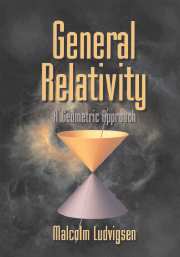Book contents
- Frontmatter
- Contents
- Preface
- PART ONE THE CONCEPT OF SPACETIME
- PART TWO FLAT SPACETIME AND SPECIAL RELATIVITY
- PART THREE CURVED SPACETIME AND GRAVITY
- 9 Curved Spacetime
- 10 Curvature and Gravity
- 11 Null Congruences
- 12 Asymptotic Flatness and Symmetries
- 13 Schwarzschild Geometries and Spacetimes
- 14 Black Holes and Singularities
- PART FOUR COSMOLOGY
- Solutions and Hints to Selected Exercises
- Bibliography
- Index
10 - Curvature and Gravity
Published online by Cambridge University Press: 04 June 2010
- Frontmatter
- Contents
- Preface
- PART ONE THE CONCEPT OF SPACETIME
- PART TWO FLAT SPACETIME AND SPECIAL RELATIVITY
- PART THREE CURVED SPACETIME AND GRAVITY
- 9 Curved Spacetime
- 10 Curvature and Gravity
- 11 Null Congruences
- 12 Asymptotic Flatness and Symmetries
- 13 Schwarzschild Geometries and Spacetimes
- 14 Black Holes and Singularities
- PART FOUR COSMOLOGY
- Solutions and Hints to Selected Exercises
- Bibliography
- Index
Summary
We come now to the physical interpretation of the curvature tensor Rabcd. As we have seen, Rabcd arises from the spacetime metric, which in turn arises from the properties of inertial world lines and null rays. If there are no gravitational tidal effects, then spacetime is flat and hence Rabcd = 0. Conversely, if Rabcd = 0, then, apart from the possibility of topologies other than ℝ4, spacetime is flat and there are no gravitational tidal effects. A nonvanishing curvature tensor is thus an indication and a measure of gravity. In this chapter we shall show that a gravitational field is completely described by Rabcd. But first we need the concept of a geodesic.
Geodesics
The world line of an inertial particle has the remarkable property of being uniquely determined by its initial four-velocity vector. If we take proper time to be the parameter along the world line, then its tangent vector at any point will be a four-velocity vector. Similarly, a null ray is uniquely determined by specifying a null vector at some point, O say, and the set of all null rays through O forms a null cone N(O). We recall that it was precisely these properties of inertial world lines and null rays that allowed us to define a unique spacetime metric. Furthermore, the metric led to a unique connection and, finally, to the curvature tensor.
- Type
- Chapter
- Information
- General RelativityA Geometric Approach, pp. 96 - 105Publisher: Cambridge University PressPrint publication year: 1999



